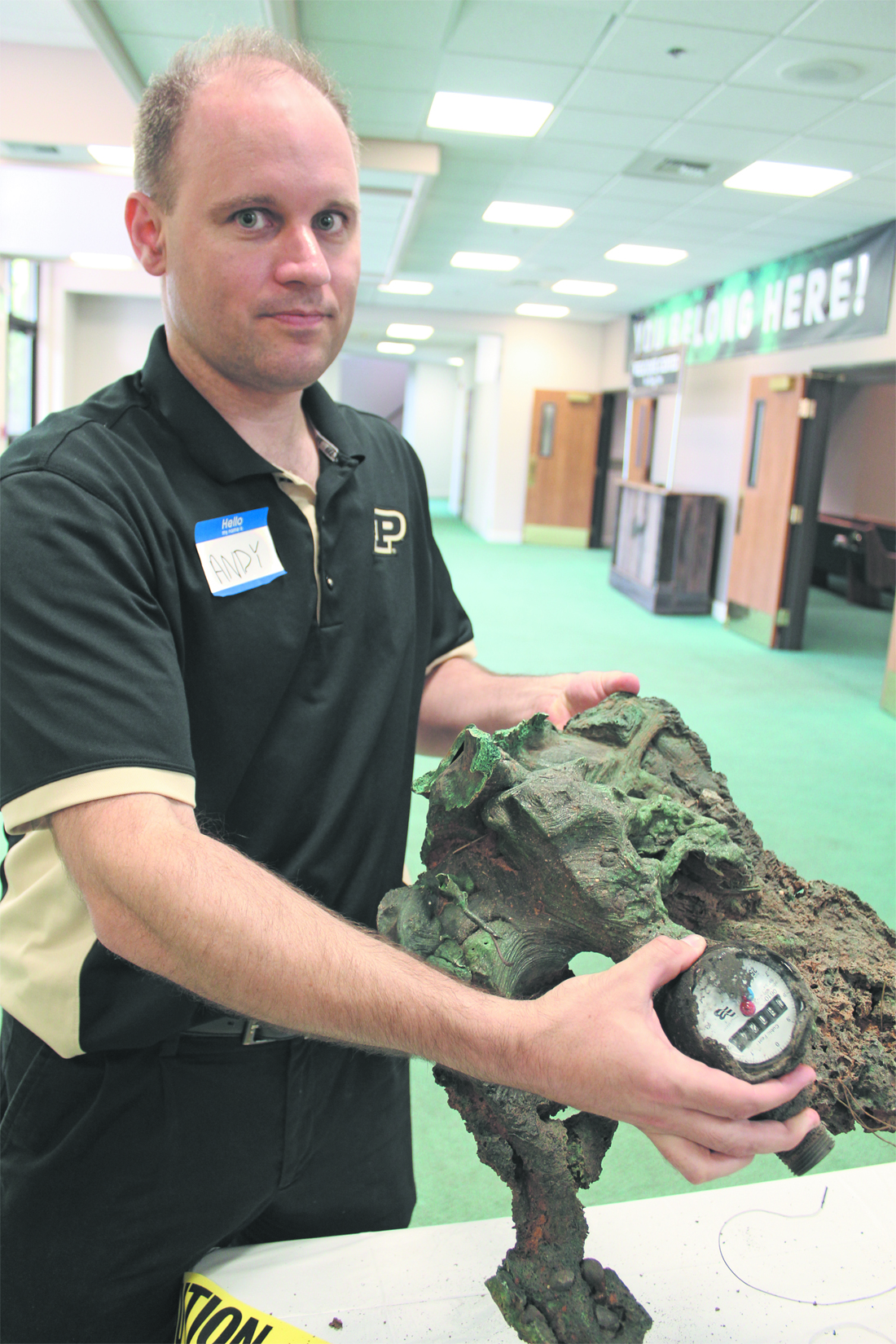
Photo by Meredith J. Cooper
Andrew Whelton holds an example of a water meter that melted into its plastic box and other debris during the Camp Fire.
Kelly Towne and her family have been staying with relatives in Hamilton City since the Camp Fire hit. Theirs is the only home standing on her block along Nunnelly Road in Paradise, and they long to return home. She’s been back, to do work around the house, but before moving back permanently she wants to be sure the water is safe.
“Everybody knows water is life,” she said during a recent interactive workshop on post-Camp Fire plumbing held at Paradise Alliance Church. “It’d be nice to know we can resume some kind of normalcy. We got the clear from Paradise Irrigation District [that our water line is safe], but we don’t know what to use—a filter or a tank? No one will recommend anything.”
After a brief reflective pause, she said, “Am I going to take years off my life?”
Towne’s concerns echo those of many of her neighbors on the Ridge. In fact, during a presentation later that evening (June 27), Caitlin Proctor, a postdoctoral researcher at Purdue University who came with a group of academics that day to talk and teach, said many residents had experienced stress or anxiety over water contamination since the fire.
She was highlighting responses to a survey conducted over two weeks in May. It asked 90 questions of people living within the Camp Fire zone and revealed a few key findings. Among them:
• Over 40 percent of people living in the Camp Fire zone who responded to the survey said they’d experienced anxiety and stress specifically related to drinking water contamination.
• 4.7 percent said they’d experienced an illness—most commonly headache, skin irritation and cough—since the fire that they attributed to the water. An additional 18.5 percent said they’d been sick but couldn’t say it was because of the water.
• 40.3 percent of Paradise Irrigation District (PID) customers and 41.2 percent of private well users had tested their home plumbing; only 15.8 percent of Del Oro Water Co. customers had done so. (PID maintains a do-not-drink warning, though it has determined some areas are free of contamination; Del Oro has issued no such warning to date.)
• 41.7 percent of respondents who had purchased a water tank said their insurance helped pay for it.
• Over 20 percent said they did not know if their water is contaminated.
“People are unsure of the safety of their water in the community, and that’s not great—that’s almost as bad as knowing it’s contaminated,” Proctor said.
Walking from table to table in the church’s foyer earlier in the day, one got an immediate sense of the confusion that has built since the Camp Fire hit eight months ago.
The tables were manned by students and faculty from Purdue—their visit paid for by the Paradise Rotary Club—along with colleagues from UC Berkeley, Chico State and Butte College. They ranged in topic from plumbing construction to how to take a proper water sample to how infrastructure can be affected by extreme heat. At Proctor’s table, plastic pipes from the Camp Fire burn zone that looked perfectly untouched on the outside were filled with melted plastic and other materials when viewed via cross-section.
“Building plumbing is complex,” explained Andrew Whelton, who led the Purdue team and runs the university’s Center for Plumbing Safety. His talk preceded that of Proctor that evening and provided an overview of what’s happened to date.
Through his presentation, he expressed dissatisfaction with guidelines recently released to the public by the state Water Resources Control Board and redistributed by Butte County Public Health. There were several reasons for concern, many of which already have been printed by this newspaper (see “Clash of plans,” Newslines, June 20).
A few additional ones, however, were noteworthy: The state recommends taking one water sample at one site—the kitchen sink—and from the cold faucet only. But benzene (the main contaminant found thus far) changes properties when heated—so, hot water faucets, which have their own pipes, also should be tested. (The town of Paradise has found contamination in hot water samples taken from bathroom sinks in some of its buildings.)
“The Department of Drinking Water only cares about drinking water—aka cold water,” Whelton said. “But we know plumbing, we know exposures.”
Also, the state’s guidelines take into consideration only ingestion, but benzene is known to cause health effects through inhalation and skin contact as well. In fact, the state conducted a test, the results of which the CN&R obtained from the water board last month via public records request, which documented that “several of the testers noted throat irritation and constriction after smelling the test sample(s).”
Whelton’s presentation included data from the PID and Del Oro water systems. Del Oro has maintained that its system is less contaminated than PID’s, primarily because it did not experience the same amount of depressurization.
At the time Whelton prepared his presentation, the highest level of benzene known to have been found in PID’s system was 2,217 parts per billion (the state recommends no more than 1 ppb for drinking) and the highest in Del Oro was 46. New data released last week, however, reveal 380 ppb at a burned service line on Andover Drive. The test results are available on Del Oro’s website (delorowater.com).
“I would expect more contamination to be found,” Whelton told the CN&R. “Until you test every service line, you have to acknowledge that [there might be contamination].”
